All Star Every Measure It Layers Again

Representative lifetimes of stars as a role of their masses
The change in size with time of a Sunday-like star
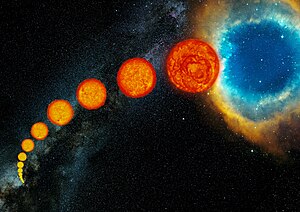
Artist'south depiction of the life cycle of a Dominicus-like star, starting as a principal-sequence star at lower left then expanding through the subgiant and behemothic phases, until its outer envelope is expelled to grade a planetary nebula at upper right
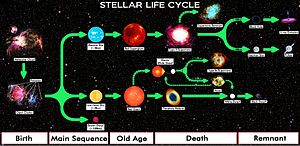
Nautical chart of stellar evolution
Stellar evolution is the process by which a star changes over the course of time. Depending on the mass of the star, its lifetime can range from a few million years for the nigh massive to trillions of years for the least massive, which is considerably longer than the age of the universe. The table shows the lifetimes of stars as a role of their masses.[ane] All stars are formed from collapsing clouds of gas and grit, often called nebulae or molecular clouds. Over the course of millions of years, these protostars settle down into a state of equilibrium, becoming what is known as a primary-sequence star.
Nuclear fusion powers a star for most of its being. Initially the free energy is generated by the fusion of hydrogen atoms at the core of the master-sequence star. Later, equally the preponderance of atoms at the core becomes helium, stars like the Sun begin to fuse hydrogen along a spherical trounce surrounding the core. This process causes the star to gradually abound in size, passing through the subgiant stage until it reaches the red-giant phase. Stars with at least half the mass of the Sun tin also brainstorm to generate energy through the fusion of helium at their cadre, whereas more-massive stars tin fuse heavier elements along a series of concentric shells. Once a star similar the Sunday has wearied its nuclear fuel, its cadre collapses into a dumbo white dwarf and the outer layers are expelled every bit a planetary nebula. Stars with around 10 or more times the mass of the Sunday can explode in a supernova as their inert atomic number 26 cores plummet into an extremely dense neutron star or black hole. Although the universe is not onetime plenty for any of the smallest ruby dwarfs to have reached the terminate of their existence, stellar models propose they will slowly become brighter and hotter before running out of hydrogen fuel and becoming low-mass white dwarfs.[2]
Stellar evolution is not studied by observing the life of a single star, every bit most stellar changes occur too slowly to exist detected, even over many centuries. Instead, astrophysicists come to understand how stars evolve by observing numerous stars at various points in their lifetime, and by simulating stellar structure using computer models.
Star germination [edit]
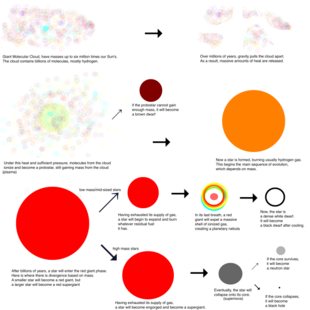
Simplistic representation of the stages of stellar evolution
Protostar [edit]
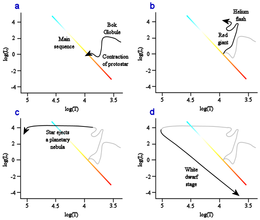
Schematic of stellar evolution
Stellar evolution starts with the gravitational collapse of a behemothic molecular deject. Typical giant molecular clouds are roughly 100 light-years (9.five×1014 km) across and contain up to half-dozen,000,000 solar masses (1.two×x37 kg). As it collapses, a giant molecular cloud breaks into smaller and smaller pieces. In each of these fragments, the collapsing gas releases gravitational potential energy every bit heat. As its temperature and pressure increase, a fragment condenses into a rotating ball of superhot gas known every bit a protostar.[3] Filamentary structures are truly ubiquitous in the molecular cloud. Dumbo molecular filaments will fragment into gravitationally bound cores, which are the precursors of stars. Continuous accretion of gas, geometrical bending, and magnetic fields may command the detailed fragmentation fashion of the filaments. In supercritical filaments, observations have revealed quasi-periodic chains of dumbo cores with spacing comparable to the filament inner width, and embedded two protostars with gas outflows.[4]
A protostar continues to grow by accession of gas and dust from the molecular cloud, becoming a pre-main-sequence star equally it reaches its final mass. Further evolution is determined by its mass. Mass is typically compared to the mass of the Sun: 1.0Thou ☉ (2.0×xxxx kg) means i solar mass.
Protostars are encompassed in grit, and are thus more readily visible at infrared wavelengths. Observations from the Wide-field Infrared Survey Explorer (WISE) have been especially important for unveiling numerous galactic protostars and their parent star clusters.[5] [6]
Brownish dwarfs and sub-stellar objects [edit]
Protostars with masses less than roughly 0.08Yard ☉ (1.6×1029 kg) never attain temperatures loftier plenty for nuclear fusion of hydrogen to brainstorm. These are known as dark-brown dwarfs. The International Astronomical Union defines brown dwarfs as stars massive enough to fuse deuterium at some point in their lives (13 Jupiter masses (Yard J), 2.five × ten28 kg, or 0.0125M ☉). Objects smaller than 13G J are classified as sub-brown dwarfs (simply if they orbit around another stellar object they are classified equally planets).[7] Both types, deuterium-burning and non, smoothen dimly and fade away slowly, cooling gradually over hundreds of millions of years.
Chief sequence stellar mass objects [edit]
For a more-massive protostar, the core temperature will eventually attain ten meg kelvin, initiating the proton–proton chain reaction and allowing hydrogen to fuse, first to deuterium and so to helium. In stars of slightly over 1M ☉ (2.0×tenxxx kg), the carbon–nitrogen–oxygen fusion reaction (CNO wheel) contributes a large portion of the free energy generation. The onset of nuclear fusion leads relatively quickly to a hydrostatic equilibrium in which energy released by the core maintains a loftier gas force per unit area, balancing the weight of the star'due south matter and preventing further gravitational plummet. The star thus evolves rapidly to a stable state, beginning the main-sequence stage of its evolution.
A new star will sit at a specific betoken on the main sequence of the Hertzsprung–Russell diagram, with the main-sequence spectral type depending upon the mass of the star. Small, relatively common cold, low-mass cerise dwarfs fuse hydrogen slowly and will remain on the primary sequence for hundreds of billions of years or longer, whereas massive, hot O-blazon stars volition leave the main sequence after just a few one thousand thousand years. A mid-sized yellowish dwarf star, like the Sun, will remain on the primary sequence for about 10 billion years. The Sunday is idea to be in the eye of its principal sequence lifespan.
Mature stars [edit]

Internal structures of principal-sequence stars, convection zones with arrowed cycles and radiative zones with cherry flashes. To the left a low-mass red dwarf, in the center a mid-sized yellow dwarf and at the correct a massive blue-white main-sequence star.
Eventually the star's core exhausts its supply of hydrogen and the star begins to evolve off the master sequence. Without the outward radiations pressure generated by the fusion of hydrogen to counteract the strength of gravity the core contracts until either electron degeneracy force per unit area becomes sufficient to oppose gravity or the cadre becomes hot enough (around 100 MK) for helium fusion to begin. Which of these happens get-go depends upon the star'southward mass.
Depression-mass stars [edit]
What happens afterwards a low-mass star ceases to produce energy through fusion has not been direct observed; the universe is around 13.8 billion years former, which is less time (past several orders of magnitude, in some cases) than it takes for fusion to cease in such stars.
Contempo astrophysical models suggest that red dwarfs of 0.iChiliad ☉ may stay on the main sequence for some six to twelve trillion years, gradually increasing in both temperature and luminosity, and take several hundred billion years more than to plummet, slowly, into a white dwarf.[9] [10] Such stars will not become ruby giants as the whole star is a convection zone and information technology will not develop a degenerate helium core with a crush called-for hydrogen. Instead, hydrogen fusion will proceed until almost the whole star is helium.
Slightly more massive stars do expand into red giants, but their helium cores are not massive enough to achieve the temperatures required for helium fusion and so they never reach the tip of the red-giant branch. When hydrogen shell burning finishes, these stars motion straight off the ruby-giant branch like a post-asymptotic-giant-branch (AGB) star, but at lower luminosity, to get a white dwarf.[two] A star with an initial mass almost 0.6M ☉ will exist able to reach temperatures high plenty to fuse helium, and these "mid-sized" stars continue to farther stages of evolution beyond the red-giant branch.[11]
Mid-sized stars [edit]
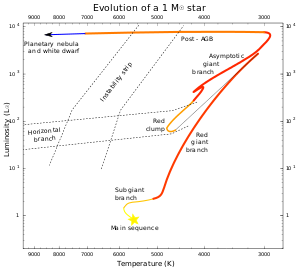
The evolutionary track of a solar mass, solar metallicity, star from main sequence to post-AGB
Stars of roughly 0.6–10M ☉ become red giants, which are large non-main-sequence stars of stellar classification Thou or Chiliad. Red giants lie forth the right edge of the Hertzsprung–Russell diagram due to their cherry-red color and large luminosity. Examples include Aldebaran in the constellation Taurus and Arcturus in the constellation of Boötes.
Mid-sized stars are red giants during ii dissimilar phases of their post-primary-sequence development: cherry-red-behemothic-branch stars, with inert cores made of helium and hydrogen-burning shells, and asymptotic-giant-branch stars, with inert cores made of carbon and helium-called-for shells within the hydrogen-burning shells.[12] Between these two phases, stars spend a menstruation on the horizontal co-operative with a helium-fusing core. Many of these helium-fusing stars cluster towards the cool terminate of the horizontal branch equally 1000-type giants and are referred to every bit carmine dodder giants.
Subgiant stage [edit]
When a star exhausts the hydrogen in its cadre, it leaves the principal sequence and begins to fuse hydrogen in a crush exterior the cadre. The core increases in mass as the shell produces more than helium. Depending on the mass of the helium core, this continues for several 1000000 to one or two billion years, with the star expanding and cooling at a similar or slightly lower luminosity to its chief sequence state. Eventually either the core becomes degenerate, in stars around the mass of the sun, or the outer layers cool sufficiently to become opaque, in more than massive stars. Either of these changes cause the hydrogen shell to increment in temperature and the luminosity of the star to increase, at which point the star expands onto the ruddy-giant branch.[13]
Red-behemothic-branch phase [edit]
The expanding outer layers of the star are convective, with the fabric being mixed by turbulence from near the fusing regions up to the surface of the star. For all but the lowest-mass stars, the fused fabric has remained deep in the stellar interior prior to this point, then the convecting envelope makes fusion products visible at the star's surface for the first time. At this stage of development, the results are subtle, with the largest effects, alterations to the isotopes of hydrogen and helium, being unobservable. The effects of the CNO bike announced at the surface during the first dredge-upwards, with lower 12C/xiiiC ratios and contradistinct proportions of carbon and nitrogen. These are detectable with spectroscopy and have been measured for many evolved stars.
The helium cadre continues to grow on the ruddy-giant co-operative. Information technology is no longer in thermal equilibrium, either degenerate or above the Schönberg–Chandrasekhar limit, so it increases in temperature which causes the rate of fusion in the hydrogen shell to increase. The star increases in luminosity towards the tip of the blood-red-giant branch. Cherry-red-giant-branch stars with a degenerate helium core all reach the tip with very similar cadre masses and very like luminosities, although the more than massive of the red giants become hot enough to ignite helium fusion before that point.
Horizontal branch [edit]
In the helium cores of stars in the 0.half dozen to two.0 solar mass range, which are largely supported by electron degeneracy pressure level, helium fusion will ignite on a timescale of days in a helium wink. In the nondegenerate cores of more massive stars, the ignition of helium fusion occurs relatively slowly with no flash.[14] The nuclear power released during the helium flash is very large, on the gild of 10eight times the luminosity of the Sun for a few days[13] and 10eleven times the luminosity of the Sun (roughly the luminosity of the Milky Manner Galaxy) for a few seconds.[15] Notwithstanding, the energy is consumed past the thermal expansion of the initially degenerate core and thus cannot be seen from outside the star.[13] [15] [xvi] Due to the expansion of the core, the hydrogen fusion in the overlying layers slows and total energy generation decreases. The star contracts, although not all the way to the main sequence, and it migrates to the horizontal branch on the Hertzsprung–Russell diagram, gradually shrinking in radius and increasing its surface temperature.
Core helium flash stars evolve to the red end of the horizontal co-operative merely exercise non migrate to college temperatures earlier they gain a degenerate carbon-oxygen core and beginning helium shell burning. These stars are oftentimes observed as a red clump of stars in the colour-magnitude diagram of a cluster, hotter and less luminous than the red giants. Higher-mass stars with larger helium cores move forth the horizontal branch to higher temperatures, some becoming unstable pulsating stars in the yellow instability strip (RR Lyrae variables), whereas some become even hotter and can form a blue tail or blue hook to the horizontal branch. The morphology of the horizontal branch depends on parameters such as metallicity, age, and helium content, but the exact details are still existence modelled.[17]
Asymptotic-giant-co-operative phase [edit]
Afterwards a star has consumed the helium at the core, hydrogen and helium fusion continues in shells effectually a hot core of carbon and oxygen. The star follows the asymptotic behemothic co-operative on the Hertzsprung–Russell diagram, paralleling the original ruby-red-giant evolution, only with fifty-fifty faster free energy generation (which lasts for a shorter time).[18] Although helium is beingness burnt in a vanquish, the bulk of the energy is produced past hydrogen burning in a vanquish farther from the cadre of the star. Helium from these hydrogen burning shells drops towards the center of the star and periodically the energy output from the helium shell increases dramatically. This is known equally a thermal pulse and they occur towards the end of the asymptotic-behemothic-branch phase, sometimes even into the mail-asymptotic-behemothic-branch phase. Depending on mass and composition, in that location may be several to hundreds of thermal pulses.
In that location is a stage on the rise of the asymptotic-giant-branch where a deep convective zone forms and tin bring carbon from the core to the surface. This is known as the second dredge up, and in some stars there may even be a third dredge up. In this way a carbon star is formed, very cool and strongly reddened stars showing strong carbon lines in their spectra. A procedure known as hot bottom burning may convert carbon into oxygen and nitrogen earlier it can be dredged to the surface, and the interaction between these processes determines the observed luminosities and spectra of carbon stars in particular clusters.[19]
Some other well known course of asymptotic-behemothic-co-operative stars is the Mira variables, which pulsate with well-defined periods of tens to hundreds of days and large amplitudes up to nearly 10 magnitudes (in the visual, total luminosity changes past a much smaller corporeality). In more-massive stars the stars become more luminous and the pulsation period is longer, leading to enhanced mass loss, and the stars get heavily obscured at visual wavelengths. These stars tin can be observed as OH/IR stars, pulsating in the infrared and showing OH maser activity. These stars are conspicuously oxygen rich, in contrast to the carbon stars, but both must be produced past dredge ups.
Post-AGB [edit]
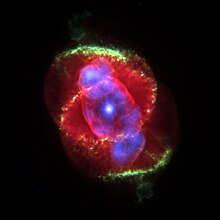
These mid-range stars ultimately reach the tip of the asymptotic-behemothic-co-operative and run out of fuel for shell burning. They are not sufficiently massive to start total-scale carbon fusion, so they contract again, going through a menstruation of post-asymptotic-giant-branch superwind to produce a planetary nebula with an extremely hot primal star. The fundamental star and then cools to a white dwarf. The expelled gas is relatively rich in heavy elements created within the star and may be specially oxygen or carbon enriched, depending on the blazon of the star. The gas builds up in an expanding vanquish called a circumstellar envelope and cools every bit it moves abroad from the star, allowing dust particles and molecules to grade. With the loftier infrared energy input from the primal star, ideal conditions are formed in these circumstellar envelopes for maser excitation.
It is possible for thermal pulses to be produced in one case post-asymptotic-giant-co-operative development has begun, producing a variety of unusual and poorly understood stars known as built-in-again asymptotic-giant-branch stars.[xx] These may upshot in extreme horizontal-co-operative stars (subdwarf B stars), hydrogen scarce post-asymptotic-giant-co-operative stars, variable planetary nebula central stars, and R Coronae Borealis variables.
Massive stars [edit]

Reconstructed image of Antares, a red supergiant
In massive stars, the core is already large enough at the onset of the hydrogen burning shell that helium ignition will occur before electron degeneracy pressure has a chance to become prevalent. Thus, when these stars expand and absurd, they do not brighten every bit dramatically as lower-mass stars; withal, they were more luminous on the primary sequence and they evolve to highly luminous supergiants. Their cores become massive enough that they cannot support themselves by electron degeneracy and will eventually collapse to produce a neutron star or black hole.[ citation needed ]
Supergiant development [edit]
Extremely massive stars (more than approximately fortyM ☉), which are very luminous and thus have very rapid stellar winds, lose mass so rapidly due to radiations pressure that they tend to strip off their own envelopes before they can expand to go carmine supergiants, and thus retain extremely high surface temperatures (and blue-white color) from their main-sequence fourth dimension onwards. The largest stars of the current generation are about 100-150Thou ☉ because the outer layers would be expelled by the extreme radiation. Although lower-mass stars unremarkably do non fire off their outer layers and so chop-chop, they can also avoid becoming reddish giants or red supergiants if they are in binary systems shut enough then that the companion star strips off the envelope as it expands, or if they rotate rapidly enough so that convection extends all the way from the core to the surface, resulting in the absence of a split core and envelope due to thorough mixing.[21]

The onion-like layers of a massive, evolved star just before cadre plummet (non to calibration)
The core of a massive star, defined equally the region depleted of hydrogen, grows hotter and denser as it accretes textile from the fusion of hydrogen outside the core. In sufficiently massive stars, the core reaches temperatures and densities high plenty to fuse carbon and heavier elements via the alpha process. At the stop of helium fusion, the cadre of a star consists primarily of carbon and oxygen. In stars heavier than about eightM ☉, the carbon ignites and fuses to form neon, sodium, and magnesium. Stars somewhat less massive may partially ignite carbon, but they are unable to fully fuse the carbon before electron degeneracy sets in, and these stars will eventually get out an oxygen-neon-magnesium white dwarf.[22] [23]
The exact mass limit for total carbon burning depends on several factors such as metallicity and the detailed mass lost on the asymptotic giant branch, only is approximately 8-9M ☉.[22] Subsequently carbon burning is complete, the core of these stars reaches about 2.5Yard ☉ and becomes hot enough for heavier elements to fuse. Before oxygen starts to fuse, neon begins to capture electrons which triggers neon burning. For a range of stars of approximately 8-12G ☉, this process is unstable and creates runaway fusion resulting in an electron capture supernova.[24] [23]
In more than massive stars, the fusion of neon proceeds without a runaway deflagration. This is followed in plow by complete oxygen burning and silicon burning, producing a core consisting largely of atomic number 26-peak elements. Surrounding the core are shells of lighter elements still undergoing fusion. The timescale for consummate fusion of a carbon core to an iron cadre is so curt, just a few hundred years, that the outer layers of the star are unable to react and the appearance of the star is largely unchanged. The fe cadre grows until information technology reaches an effective Chandrasekhar mass, higher than the formal Chandrasekhar mass due to various corrections for the relativistic furnishings, entropy, charge, and the surrounding envelope. The effective Chandrasekhar mass for an iron cadre varies from near i.34G ☉ in the least massive ruby supergiants to more than i.viiiM ☉ in more massive stars. Once this mass is reached, electrons begin to be captured into the iron-peak nuclei and the core becomes unable to support itself. The core collapses and the star is destroyed, either in a supernova or direct plummet to a black hole.[23]
Supernova [edit]
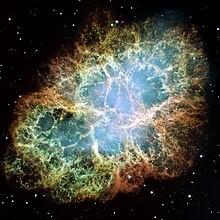
The Crab Nebula, the shattered remnants of a star which exploded as a supernova visible in 1054 AD
When the core of a massive star collapses, it volition grade a neutron star, or in the instance of cores that exceed the Tolman–Oppenheimer–Volkoff limit, a black pigsty. Through a procedure that is not completely understood, some of the gravitational potential energy released by this core collapse is converted into a Type Ib, Type Ic, or Type II supernova. It is known that the core collapse produces a massive surge of neutrinos, as observed with supernova SN 1987A. The extremely energetic neutrinos fragment some nuclei; some of their energy is consumed in releasing nucleons, including neutrons, and some of their energy is transformed into rut and kinetic energy, thus augmenting the shock wave started by rebound of some of the infalling material from the collapse of the cadre. Electron capture in very dense parts of the infalling thing may produce additional neutrons. Because some of the rebounding matter is bombarded by the neutrons, some of its nuclei capture them, creating a spectrum of heavier-than-fe cloth including the radioactive elements up to (and probable beyond) uranium.[25] Although non-exploding red giants can produce significant quantities of elements heavier than iron using neutrons released in side reactions of earlier nuclear reactions, the abundance of elements heavier than fe (and in detail, of certain isotopes of elements that have multiple stable or long-lived isotopes) produced in such reactions is quite different from that produced in a supernova. Neither abundance solitary matches that constitute in the Solar Organisation, so both supernovae and ejection of elements from red giants are required to explicate the observed affluence of heavy elements and isotopes thereof.
The energy transferred from collapse of the cadre to rebounding material not only generates heavy elements, but provides for their acceleration well beyond escape velocity, thus causing a Blazon Ib, Type Ic, or Type II supernova. Current understanding of this free energy transfer is still non satisfactory; although current calculator models of Type Ib, Type Ic, and Type II supernovae business relationship for office of the energy transfer, they are not able to account for enough free energy transfer to produce the observed ejection of material.[26] However, neutrino oscillations may play an important office in the energy transfer problem as they not only bear on the energy available in a detail flavour of neutrinos merely as well through other general-relativistic furnishings on neutrinos.[27] [28]
Some evidence gained from analysis of the mass and orbital parameters of binary neutron stars (which require two such supernovae) hints that the plummet of an oxygen-neon-magnesium cadre may produce a supernova that differs observably (in ways other than size) from a supernova produced past the plummet of an iron core.[29]
The most massive stars that be today may be completely destroyed past a supernova with an energy greatly exceeding its gravitational binding free energy. This rare event, caused past pair-instability, leaves behind no blackness pigsty remnant.[30] In the past history of the universe, some stars were even larger than the largest that exists today, and they would immediately collapse into a black pigsty at the stop of their lives, due to photodisintegration.

Stellar evolution of low-mass (left cycle) and high-mass (right cycle) stars, with examples in italics
Stellar remnants [edit]
Afterward a star has burned out its fuel supply, its remnants tin take ane of 3 forms, depending on the mass during its lifetime.
White and black dwarfs [edit]
For a star of 1Chiliad ☉, the resulting white dwarf is of nigh 0.6M ☉, compressed into approximately the book of the World. White dwarfs are stable because the inward pull of gravity is counterbalanced by the degeneracy pressure of the star's electrons, a consequence of the Pauli exclusion principle. Electron degeneracy pressure provides a rather soft limit against further compression; therefore, for a given chemical composition, white dwarfs of higher mass have a smaller volume. With no fuel left to burn down, the star radiates its remaining heat into space for billions of years.
A white dwarf is very hot when it first forms, more than 100,000 K at the surface and fifty-fifty hotter in its interior. Information technology is and so hot that a lot of its energy is lost in the form of neutrinos for the first 10 1000000 years of its existence and will have lost most of its energy afterward a billion years.[31]
The chemic composition of the white dwarf depends upon its mass. A star that has a mass of almost eight-12 solar masses will ignite carbon fusion to form magnesium, neon, and smaller amounts of other elements, resulting in a white dwarf composed chiefly of oxygen, neon, and magnesium, provided that it can lose enough mass to become below the Chandrasekhar limit (run across beneath), and provided that the ignition of carbon is not so violent as to blow the star apart in a supernova.[32] A star of mass on the order of magnitude of the Sun will be unable to ignite carbon fusion, and volition produce a white dwarf composed chiefly of carbon and oxygen, and of mass also low to collapse unless thing is added to it later on (encounter below). A star of less than about half the mass of the Sun volition be unable to ignite helium fusion (as noted earlier), and will produce a white dwarf equanimous chiefly of helium.
In the cease, all that remains is a cold dark mass sometimes called a blackness dwarf. Withal, the universe is not former enough for whatever blackness dwarfs to exist all the same.
If the white dwarf's mass increases in a higher place the Chandrasekhar limit, which is ane.4M ☉ for a white dwarf equanimous importantly of carbon, oxygen, neon, and/or magnesium, then electron degeneracy pressure fails due to electron capture and the star collapses. Depending upon the chemic limerick and pre-collapse temperature in the center, this volition lead either to collapse into a neutron star or runaway ignition of carbon and oxygen. Heavier elements favor continued core collapse, because they require a higher temperature to ignite, considering electron capture onto these elements and their fusion products is easier; higher cadre temperatures favor delinquent nuclear reaction, which halts core collapse and leads to a Type Ia supernova.[33] These supernovae may be many times brighter than the Type 2 supernova marking the death of a massive star, even though the latter has the greater full energy release. This instability to collapse means that no white dwarf more massive than approximately 1.4M ☉ tin can exist (with a possible modest exception for very rapidly spinning white dwarfs, whose centrifugal force due to rotation partially counteracts the weight of their matter). Mass transfer in a binary system may crusade an initially stable white dwarf to surpass the Chandrasekhar limit.
If a white dwarf forms a close binary system with some other star, hydrogen from the larger companion may accrete effectually and onto a white dwarf until information technology gets hot enough to fuse in a delinquent reaction at its surface, although the white dwarf remains beneath the Chandrasekhar limit. Such an explosion is termed a nova.
Neutron stars [edit]

Chimera-like daze wave nonetheless expanding from a supernova explosion 15,000 years ago
Normally, atoms are by and large electron clouds past volume, with very compact nuclei at the center (proportionally, if atoms were the size of a football stadium, their nuclei would be the size of dust mites). When a stellar core collapses, the force per unit area causes electrons and protons to fuse by electron capture. Without electrons, which keep nuclei apart, the neutrons collapse into a dense ball (in some ways like a giant diminutive nucleus), with a thin overlying layer of degenerate affair (importantly fe unless matter of different limerick is added later). The neutrons resist further compression by the Pauli exclusion principle, in a style analogous to electron degeneracy pressure, but stronger.
These stars, known as neutron stars, are extremely small—on the order of radius ten km, no bigger than the size of a large city—and are phenomenally dumbo. Their flow of rotation shortens dramatically as the stars compress (due to conservation of angular momentum); observed rotational periods of neutron stars range from about 1.5 milliseconds (over 600 revolutions per 2d) to several seconds.[34] When these rapidly rotating stars' magnetic poles are aligned with the World, we detect a pulse of radiations each revolution. Such neutron stars are called pulsars, and were the start neutron stars to be discovered. Though electromagnetic radiation detected from pulsars is most often in the form of radio waves, pulsars have also been detected at visible, X-ray, and gamma ray wavelengths.[35]
Black holes [edit]
If the mass of the stellar remnant is high plenty, the neutron degeneracy pressure will be insufficient to prevent collapse below the Schwarzschild radius. The stellar remnant thus becomes a blackness hole. The mass at which this occurs is not known with certainty, simply is currently estimated at betwixt 2 and 3M ☉.
Black holes are predicted by the theory of general relativity. Co-ordinate to classical general relativity, no matter or data can flow from the interior of a black hole to an exterior observer, although quantum effects may allow deviations from this strict dominion. The existence of black holes in the universe is well supported, both theoretically and by astronomical observation.
Because the core-collapse mechanism of a supernova is, at present, only partially understood, it is still not known whether it is possible for a star to collapse straight to a black hole without producing a visible supernova, or whether some supernovae initially form unstable neutron stars which and so collapse into black holes; the exact relation betwixt the initial mass of the star and the final remnant is also not completely certain. Resolution of these uncertainties requires the analysis of more supernovae and supernova remnants.
Models [edit]
A stellar evolutionary model is a mathematical model that can be used to compute the evolutionary phases of a star from its formation until it becomes a remnant. The mass and chemical composition of the star are used as the inputs, and the luminosity and surface temperature are the just constraints. The model formulae are based upon the physical understanding of the star, commonly under the assumption of hydrostatic equilibrium. All-encompassing reckoner calculations are then run to determine the changing country of the star over fourth dimension, yielding a table of data that can be used to decide the evolutionary rail of the star across the Hertzsprung–Russell diagram, forth with other evolving properties.[36] Accurate models can be used to estimate the current age of a star by comparing its concrete properties with those of stars along a matching evolutionary track.[37]
See also [edit]
- Galaxy formation and development – From a homogeneous beginning, the formation of the first galaxies, the way galaxies modify over fourth dimension
- Chronology of the universe – History and future of the universe
- Template:Nature timeline
- Nucleosynthesis – Process that creates new atomic nuclei from pre-existing nucleons, primarily protons and neutrons
- Standard solar model
- Stellar population – Grouping of stars by like metallicity (metallicity)
- Stellar rotation § Later on formation – Angular movement of a star about its axis – Rotations slow as stars age
- Timeline of stellar astronomy
References [edit]
- ^ Bertulani, Carlos A. (2013). Nuclei in the Cosmos. World Scientific. ISBN978-981-4417-66-two.
- ^ a b Laughlin, Gregory; Bodenheimer, Peter; Adams, Fred C. (1997). "The Stop of the Master Sequence". The Astrophysical Journal. 482 (ane): 420–432. Bibcode:1997ApJ...482..420L. doi:x.1086/304125.
- ^ Prialnik (2000, Chapter 10)
- ^ Zhang, Guo-Yin; André, Ph.; Men'shchikov, A.; Wang, Ke (i October 2020). "Fragmentation of star-forming filaments in the X-shaped nebula of the California molecular cloud". Astronomy and Astrophysics. 642: A76. arXiv:2002.05984. Bibcode:2020A&A...642A..76Z. doi:10.1051/0004-6361/202037721. ISSN 0004-6361. S2CID 211126855.
- ^ "Broad-field Infrared Survey Explorer Mission". NASA.
- ^ Majaess, D. (2013). Discovering protostars and their host clusters via WISE, ApSS, 344, 1 (VizieR catalog)
- ^ "Working Group on Extrasolar Planets: Definition of a "Planet"". IAU position argument. 2003-02-28. Archived from the original on February four, 2012. Retrieved 2012-05-thirty .
- ^ Prialnik (2000, Fig. viii.19, p. 174)
- ^ "Why the Smallest Stars Stay Small-scale". Sky & Telescope (22). November 1997.
- ^ Adams, F. C.; P. Bodenheimer; G. Laughlin (2005). "M dwarfs: planet formation and long term evolution". Astronomische Nachrichten. 326 (10): 913–919. Bibcode:2005AN....326..913A. doi:x.1002/asna.200510440.
- ^ Lejeune, T; Schaerer, D (2001). "Database of Geneva stellar evolution tracks and isochrones for , HST-WFPC2, Geneva and Washington photometric systems". Astronomy & Astrophysics. 366 (two): 538–546. arXiv:astro-ph/0011497. Bibcode:2001A&A...366..538L. doi:10.1051/0004-6361:20000214. S2CID 6708419.
- ^ Hansen, Kawaler & Trimble (2004, pp. 55–56)
- ^ a b c Ryan & Norton (2010, p. 115)
- ^ Ryan & Norton (2010, p. 125)
- ^ a b Prialnik (2000, p. 151)
- ^ Deupree, R. G. (1996-11-01). "A Reexamination of the Core Helium Flash". The Astrophysical Journal. 471 (one): 377–384. Bibcode:1996ApJ...471..377D. CiteSeerX10.i.ane.31.44. doi:ten.1086/177976.
- ^ Gratton, R. G.; Carretta, Eastward.; Bragaglia, A.; Lucatello, Due south.; d'Orazi, 5. (2010). "The second and 3rd parameters of the horizontal branch in globular clusters". Astronomy and Astrophysics. 517: A81. arXiv:1004.3862. Bibcode:2010A&A...517A..81G. doi:ten.1051/0004-6361/200912572. S2CID 55701280.
- ^ Sackmann, I. -J.; Boothroyd, A. I.; Kraemer, K. Eastward. (1993). "Our Sun. Iii. Present and Future". The Astrophysical Journal. 418: 457. Bibcode:1993ApJ...418..457S. doi:ten.1086/173407.
- ^ van Loon; Zijlstra; Whitelock; Peter te Lintel Hekkert; Chapman; Cecile Loup; Groenewegen; Waters; Trams (1998). "Obscured Asymptotic Giant Branch stars in the Magellanic Clouds IV. Carbon stars and OH/IR stars" (PDF). Astronomy and Astrophysics. 329 (ane): 169–85. arXiv:astro-ph/9709119v1. Bibcode:1996MNRAS.279...32Z. CiteSeerXten.1.1.389.3269. doi:10.1093/mnras/279.1.32.
- ^ Heber, U. (1991). "Atmospheres and Abundances of Blueish Horizontal Co-operative Stars and Related Objects". Evolution of Stars: The Photospheric Affluence Connection: Proceedings of the 145th Symposium of the International Astronomical Wedlock. 145: 363. Bibcode:1991IAUS..145..363H.
- ^ Vanbeveren, D.; De Loore, C.; Van Rensbergen, W. (1998). "Massive stars". The Astronomy and Astrophysics Review. 9 (one–2): 63–152. Bibcode:1998A&ARv...9...63V. doi:10.1007/s001590050015. S2CID 189933559.
- ^ a b Jones, Southward.; Hirschi, R.; Nomoto, Yard.; Fischer, T.; Timmes, F. X.; Herwig, F.; Paxton, B.; Toki, H.; Suzuki, T.; Martínez-Pinedo, G.; Lam, Y. H.; Bertolli, 1000. G. (2013). "Advanced Called-for Stages and Fate of 8-10M☉Stars". The Astrophysical Journal. 772 (two): 150. arXiv:1306.2030. Bibcode:2013ApJ...772..150J. doi:ten.1088/0004-637X/772/2/150. S2CID 118687195.
- ^ a b c Woosley, Due south. E.; Heger, A.; Weaver, T. A. (2002). "The development and explosion of massive stars". Reviews of Modern Physics. 74 (4): 1015–1071. Bibcode:2002RvMP...74.1015W. doi:x.1103/RevModPhys.74.1015. S2CID 55932331.
- ^ Ken'ichi Nomoto (1987). "Development of 8–ten One thousand ☉ stars toward electron capture supernovae. Two – Collapse of an O + Ne + Mg core". Astrophysical Journal. 322: 206–214. Bibcode:1987ApJ...322..206N. doi:ten.1086/165716.
- ^ How do Massive Stars Explode? Archived 2003-06-27 at the Wayback Machine
- ^ Robert Buras; et al. (June 2003). "Supernova Simulations Yet Defy Explosions". Research Highlights. Max-Planck-Institut für Astrophysik. Archived from the original on 2003-08-03.
- ^ Ahluwalia-Khalilova, D. Five (2004). "Addendum to: Gen. Rel. Grav. 28 (1996) 1161, Get-go Prize Essay for 1996: Neutrino Oscillations and Supernovae". General Relativity and Gravitation. 36 (9): 2183–2187. arXiv:astro-ph/0404055. Bibcode:2004GReGr..36.2183A. doi:x.1023/B:GERG.0000038633.96716.04. S2CID 1045277.
- ^ Yang, Yue; Kneller, James P (2017). "GR effects in supernova neutrino flavour transformations". Physical Review D. 96 (2): 023009. arXiv:1705.09723. Bibcode:2017PhRvD..96b3009Y. doi:ten.1103/PhysRevD.96.023009. S2CID 119190550.
- ^ E. P. J. van den Heuvel (2004). "Ten-Ray Binaries and Their Descendants: Binary Radio Pulsars; Evidence for Iii Classes of Neutron Stars?". Proceedings of the fifth INTEGRAL Workshop on the INTEGRAL Universe (ESA SP-552). 552: 185–194. arXiv:astro-ph/0407451. Bibcode:2004ESASP.552..185V.
- ^ Pair Instability Supernovae and Hypernovae., Nicolay J. Hammer, (2003), accessed May 7, 2007. Archived June 8, 2012, at the Wayback Automobile
- ^ "Fossil Stars (1): White Dwarfs".
- ^ Ken'ichi Nomoto (1984). "Evolution of viii–10 M ☉ stars toward electron capture supernovae. I – Formation of electron-degenerate O + Ne + Mg cores". Astrophysical Journal. 277: 791–805. Bibcode:1984ApJ...277..791N. doi:ten.1086/161749.
- ^ Ken'ichi Nomoto & Yoji Kondo (1991). "Weather for accession-induced collapse of white dwarfs". Astrophysical Journal. 367: L19–L22. Bibcode:1991ApJ...367L..19N. doi:10.1086/185922.
- ^ D'Amico, N.; Stappers, B. West.; Bailes, M.; Martin, C. E.; Bell, J. F.; Lyne, A. Grand.; Manchester, R. N. (1998). "The Parkes Southern Pulsar Survey - 3. Timing of long-menstruation pulsars". Monthly Notices of the Royal Astronomical Society. 297 (one): 28–forty. Bibcode:1998MNRAS.297...28D. doi:10.1046/j.1365-8711.1998.01397.x.
- ^ Courtland, Rachel (17 October 2008). "Pulsar Detected by Gamma Waves Only". New Scientist. Archived from the original on April 2, 2013.
- ^ Demarque, P.; Guenther, D. B.; Li, L. H.; Mazumdar, A.; Straka, C. W. (August 2008). "YREC: the Yale rotating stellar evolution lawmaking". Astrophysics and Space Science. 316 (1–four): 31–41. arXiv:0710.4003. Bibcode:2008Ap&SS.316...31D. doi:10.1007/s10509-007-9698-y. ISBN9781402094408. S2CID 14254892.
- ^ Ryan & Norton (2010, p. 79, "Assigning ages from hydrogen-burning timescales")
- Hansen, Carl J.; Kawaler, Steven D.; Trimble, Virginia (2004). Stellar interiors: physical principles, structure, and evolution (2nd ed.). Springer-Verlag. ISBN0-387-20089-4.
- Prialnik, Dina (2000). An Introduction to the Theory of Stellar Structure and Evolution. Cambridge University Printing. ISBN0-521-65065-eight.
- Ryan, Sean G.; Norton, Andrew J. (2010). Stellar Development and Nucleosynthesis. Cambridge Academy Press. ISBN978-0-521-13320-3.
Farther reading [edit]
- Astronomy 606 (Stellar Structure and Evolution) lecture notes, Cole Miller, Department of Astronomy, Academy of Maryland
- Astronomy 162, Unit 2 (The Structure & Evolution of Stars) lecture notes, Richard W. Pogge, Department of Astronomy, Ohio Land University
External links [edit]
- Stellar evolution simulator
- Pisa Stellar Models
- MESA stellar development codes (Modules for Experiments in Stellar Astrophysics)
- "The Life of Stars", BBC Radio four discussion with Paul Murdin, Janna Levin and Phil Charles (In Our Fourth dimension, Mar. 27, 2003)
fancherscablevoled.blogspot.com
Source: https://en.wikipedia.org/wiki/Stellar_evolution

0 Response to "All Star Every Measure It Layers Again"
Post a Comment